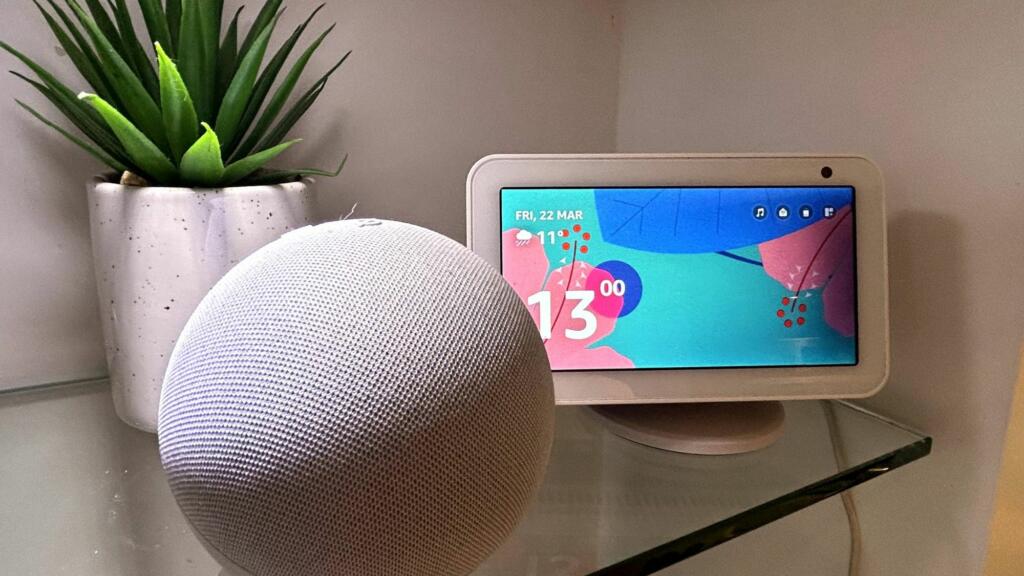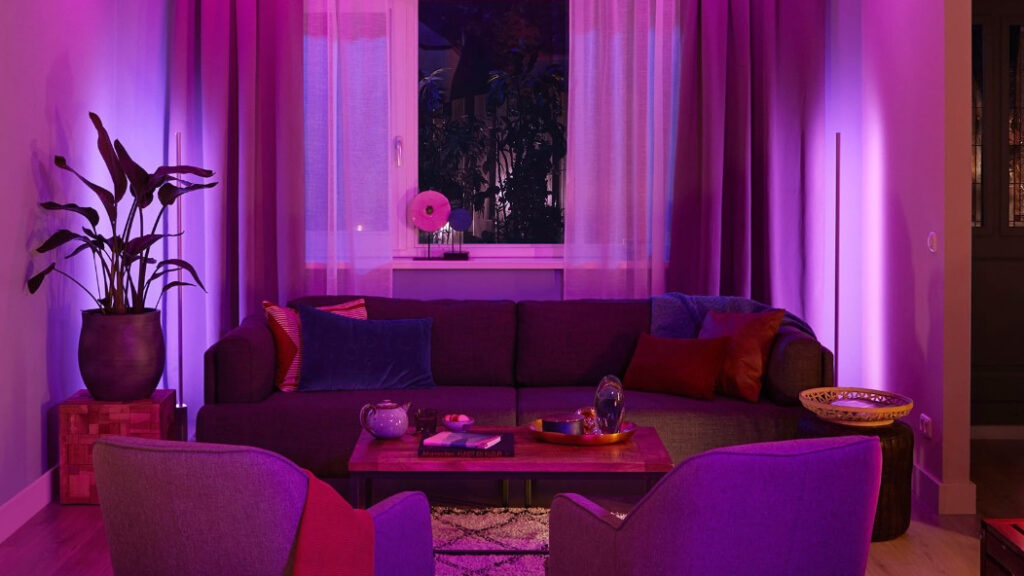
Smart speaker vs smart display: what’s the difference?
David Nield
They may look identical, but there are differences between Amazon’s main Echo and smaller Echo Dot spherical speakers, ranging from smart home tech to audio abilities.
They may look the same – and use the same Alexa voice assistant – but there are some important differences between Amazon’s current-generation smart speakers. From their capabilities as a smart home command centre to how good they are at playing music and radio stations, there are various reasons for their differing size and price.
Both speakers work in fundamentally the same way, but the larger and more expensive Echo (4th-generation, 2020) is billed as the more capable music system, while also packing a couple of extra features to help justify its higher price.
Some buyers will want these extra features, but for others they might not be worth the extra money compared to the smaller Echo Dot (5th-generation, 2022).
They may look the same – and use the same Alexa voice assistant – but there are some important differences between Amazon’s current-generation smart speakers. From their capabilities as a smart home command centre to how good they are at playing music and radio stations, there are various reasons for their differing size and price.
Both speakers work in fundamentally the same way, but the larger and more expensive Echo (4th-generation, 2020) is billed as the more capable music system, while also packing a couple of extra features to help justify its higher price.
Some buyers will want these extra features, but for others they might not be worth the extra money compared to the smaller Echo Dot (5th-generation, 2022).
 Credit: Amazon/Saga Exceptional
Credit: Amazon/Saga ExceptionalOur guide will help you work out which is best for you, whether you‘re buying your first smart speaker, or looking to add a second, third or fourth Echo to your Alexa-powered smart home system.
Why have we mentioned the generations?
Amazon tends to release new versions of existing products every few years, and it likes to keep the name of the products the same. The generations allow you to keep track of which versions we’re referring to.
In this case, at time of writing, the 4th-gen Echo (released in 2020) and 5th-gen Echo Dot (released in 2022) are the most recent versions of their respective product lines.
Both of these speakers are Amazon’s latest offerings, with the Echo (4th gen) arriving in 2020 and the Echo Dot (5th gen) coming along in 2022.
Their prices fluctuate frequently, especially on Amazon’s own website, but the RRP is £110 for the larger Echo and £55 for the smaller Echo Dot. However, keep an eye out for deals that can sometimes see the Echo fall to as low as £55, and for the Echo Dot to cost around £30.
They are both almost always available with free same-day delivery for Amazon Prime subscribers. The speakers can also be bought from other retailers, like Currys, Argos and John Lewis.
The Echo Dot is Amazon’s entry-level smart speaker. It sits below the midrange Echo, which in turn is superseded by the flagship Echo Studio, at £220.
Amazon also sells the Echo Dot (5th gen) with clock, which is the same as the regular Dot but costs £10 more and has a simple digital clock face on its front.
Broadly speaking, the Echo Dot’s closest rival is the Google Nest Mini, while the full-size Echo goes up against the Google Nest Audio.
Similarly, Apple’s HomePod Mini is a rival (albeit a more expensive one) to the Echo Dot, while the bigger HomePod is a more premium product. If you want higher sound quality and more audio features, but still want to use Alexa, try looking at smart speakers from Sonos.
Size: 144 x 144 x 133mm (5 x 5 x 4.7in)
Weight: 970g (2lb 2oz)
Speaker(s): One 76.2mm (3in) neodymium woofer and two 20mm (0.8in) tweeters
Wi-Fi: Dual-band, 802.11 a/b/g/n/ac (2.4 and 5 GHz)
Bluetooth: 5.0 with A2DP
Microphone(s): Six
Voice assistant: Alexa
Released: October 2020
Size: 100 x 100 x 89mm (4in x 4in x 3.5in)
Weight: 340g (12oz)
Speaker(s): One 44mm (1.73in) front-firing speaker
Wi-Fi: Dual-band, 802.11 a/b/g/n/ac (2.4 and 5 GHz)
Bluetooth: 5.0 with A2DP
Microphone(s): Three
Voice assistant: Alexa
Release: October 2022
These smart speakers have the same spherical design, and homely fabric covers available in black, white or blue. There’s also an LED light ring on their base for indicating what the speaker and its voice assistant are doing.
The softness of their aesthetics should help them blend in neatly with the decor of your home, and not stick out awkwardly like the black plastic sound systems of old.
The only visual difference between these two speakers is their size, with the Echo being 44% taller and wider than the Echo Dot.
Battery bases (although not made by Amazon), are available for both speakers, making them portable and wireless for a few hours at a time.
Various third-party wall mounting options are available for both speakers, but only the larger Echo has a screw hole in its base for different wall and ceiling mounting options.
 Credit: Amazon
Credit: AmazonAmazon’s Alexa voice assistant works in the same way on both Echo speakers. Alexa starts listening when you say its name, or you can use the Alexa smartphone app to change this so-called ‘wake word’ to Echo, Amazon, Computer or Ziggy – handy if someone in your household is also called Alexa.
The assistant can be used to answer general knowledge questions, and read the weather forecast and news headlines. It can also cue up a music playlist or radio station, flip a virtual coin or roll a virtual dice, set alarms and timers, and control thousands of smart home devices.
If you’re concerned about privacy, it may be useful to know that Alexa is only listening for its wake word, and only after hearing it does it record what you say. This is then uploaded to Amazon’s cloud servers and processed, before a response is found (an answer to your question, perhaps), and sent back to the Echo, which then delivers the reply. All of this happens in a couple of seconds.
 Credit: Amazon
Credit: AmazonAlexa is smart enough to understand context, so you can ask about tomorrow’s weather forecast, then ask: “Will it rain?” and Alexa will know that you mean tomorrow and not today.
Smart home control is a huge topic worthy of its own guide. But for now it’s worth saying that Alexa works with just about everything, from smart light bulbs by Philips Hue and smart plugs from TP-Link, to Ring Video Doorbells and Yale smart door locks.
It also pairs with air quality monitors, motorised window blinds, robotic vacuum cleaners, garden irrigation systems and even connected cars (vehicles that can connect to the internet to control items and products remotely).
These products are added to the assistant using the Alexa app. After that you can ask your Echo or Echo Dot to turn on lights, adjust the thermostat, lock the door, vacuum the lounge carpet, check the battery level of your electric car, and much more. Alexa’s routines tool can be used to create automation systems where one voice command can have several things happen at once.
Lastly, when it comes to smart home tech, the Echo has Zigbee and the Echo Dot does not. Zigbee is a wireless technology used by some smart home devices to communicate directly with each other instead of via a smartphone app or your internet router.
The Echo Dot still works with most wi-fi-based smart home devices – but if you’re after the best smart speaker to act as a hub to control Zigbee devices, the Echo is the way to go.
 Credit: Amazon
Credit: AmazonWe mentioned earlier how both speakers have an LED light ring on their base. This is used to indicate what Alexa is doing, shining blue when the voice assistant is listening, thinking and speaking; red when the microphone is muted; and yellow when your Amazon account has an unread message or notification (often about an upcoming delivery).
Both speakers have a set of four buttons on the top. Two are used to adjust the volume (the level of which is indicated by the light ring turning white), one mutes the microphone, and one gets Alexa’s attention without you needing to say the assistant’s name. Tapping the top of either speaker pauses music and snoozes the alarm.
The back of the speakers is where things start to differ. Both have a detachable power cable for plugging into a mains socket, but only the larger Echo has a 3.5mm (0.14in) audio connection. The Alexa app lets you choose whether this is an input or output, so the Echo can be used as a speaker for a record player, for example, or the Echo’s audio can be sent to another sound system.
All Echo products are set up using the Alexa smartphone app, and if you already have an Amazon account, the whole process takes just a couple of minutes. If you already have an Echo speaker, adding a second takes just a few seconds.
This is where the biggest differences are. The larger Echo contains three speakers: a woofer pointed upwards and forwards from the top of the sphere, and a pair of tweeters sat below the woofer and angled slightly outwards to the left and right. This creates a fairly broad soundstage for a relatively compact speaker.
The larger Echo also benefits from the ability to play lossless high–definition music with Dolby audio.
What is lossless audio?
Lossless is a type of audio compression where no data is lost in the process of reducing the file size, ensuring the original quality of the recording is maintained resulting in high-quality playback.
By comparison, the smaller Echo Dot has just one speaker, firing forwards and upwards, and no Dolby support. This means the Dot is quieter, with a smaller and narrower soundstage.
The sound it produces isn’t as detailed as the Echo and it lacks bass, so is better suited to smaller rooms. Ideally, the Echo Dot is a smart speaker for your desk or bedside table.
Adding multiple Echo devices to your home unlocks new features. A pair (or more) can be used as a home intercom system, or for making house-wide announcements for everyone to hear.
It’s also possible to wirelessly connect two of the same Echo speaker together (two Echoes, or two Echo Dots, for example), creating a stereo pair for better-sounding music. A pair of the same Echo speakers can also be added to Amazon’s Fire TV streaming products to act as the rear speakers of a surround sound system.
 Credit: Amazon
Credit: AmazonChoosing between these Alexa smart speakers will come down to your budget, but also where you plan to put them.
The Echo Dot represents fantastic value, especially when discounted to £35, as it sometimes is, because it has the same Alexa intelligence as every other Echo device. It is compact and ideally suited to playing music and radio at low to medium volume levels.
The larger Echo is twice the price, but still represents good value, given Alexa’s abilities and the improved audio performance over the Echo Dot. It is better suited to larger spaces and for buyers who want good quality music, not just a quiet radio to fill the background of their day.
Although better than the previous generation of Dot, the latest model is still confined by the technical limitations of its single small speaker.
That said, there is room in almost all households for the Echo and the Echo Dot. The former works best in the kitchen or lounge – where a stereo pair could be connected to a record player, for example – while the Dot is a great addition to your bedside table, working as a radio, alarm and smart home controller.

Written by Alistair Charlton he/him
Published: Updated:
Alistair has been a technology and automotive journalist since 2011. He specialises in smart home tech, from speakers and displays, to smart lighting, plugs, audio systems, security cameras and TV streaming devices.
Alistair has tested hundreds of products during his career and as a freelancer he currently writes for Wired, T3, Forbes, The Independent, TechRadar, BBC Science Focus and Grand Designs, among others.
When he’s not installing smart lighting and configuring home automation systems, he’s testing out some of the world’s most desirable cars and interviewing the people behind them.

David Nield

Alistair Charlton

Jayne Cherrington-Cook

Carrie Marshall